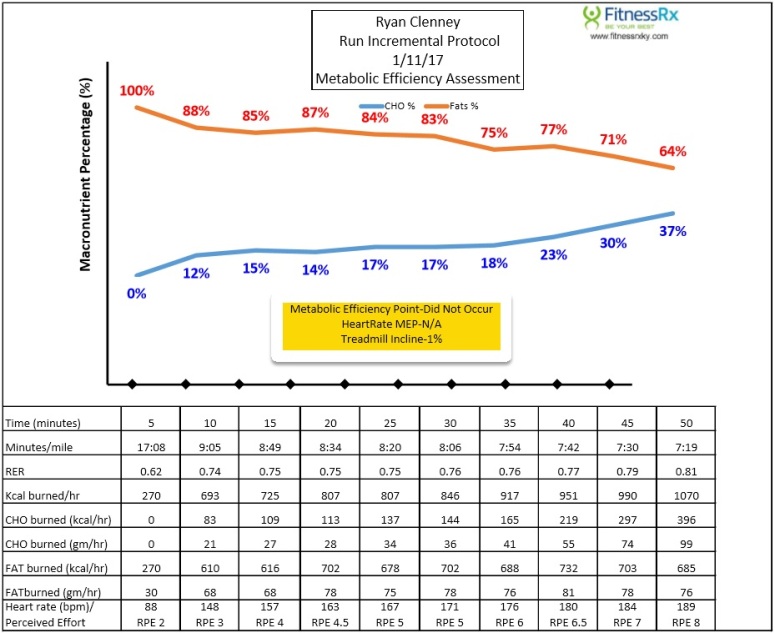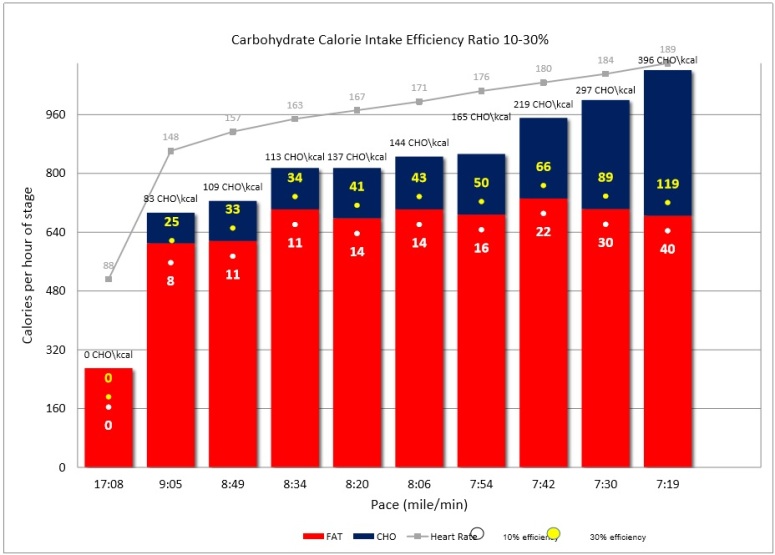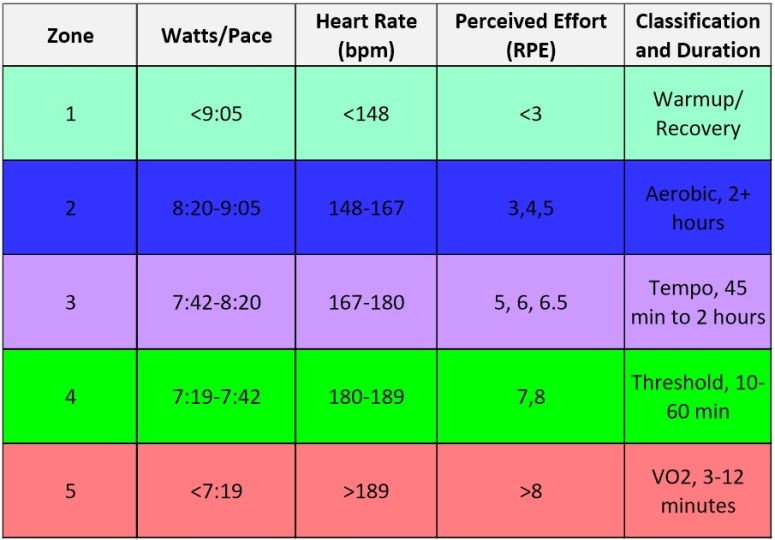Below are the comprehensive results from my MET test. In my original post, I went over the testing protocol and what I was hoping to learn. The team at FitnessRx KY provided detailed results along with some feedback from a doctor trained in interpreting Metabolic Efficiency information. This information has proven extremely useful in setting training zones as well as understanding my unique fueling needs (or lack thereof!)
 This chart shows how my body utilizes fat and carbohydrates at varying exercise intensities. Most athletes have a “crossover point” where the body switches to carbohydrates as the primary fuel source. What’s interesting is the fact that I don’t have a crossover point. Even at relatively high intensities, I’m burning fat at an extremely high rate. This is a direct result of the dietary changes I’ve made over the last few months (high fat, low carb diet).
This chart shows how my body utilizes fat and carbohydrates at varying exercise intensities. Most athletes have a “crossover point” where the body switches to carbohydrates as the primary fuel source. What’s interesting is the fact that I don’t have a crossover point. Even at relatively high intensities, I’m burning fat at an extremely high rate. This is a direct result of the dietary changes I’ve made over the last few months (high fat, low carb diet).
 MET testing helps establish a fueling strategy for long events, such as an ironman triathlon. Since I’m burning mostly fat, my need for carbs during a race is MUCH lower than what is typically prescribed. Many endurance athletes use a baseline of 240 calories per hour of carbohydrate replacement in a long event. My results suggest somewhere between 15 and 50 calories per hour would be my target.
MET testing helps establish a fueling strategy for long events, such as an ironman triathlon. Since I’m burning mostly fat, my need for carbs during a race is MUCH lower than what is typically prescribed. Many endurance athletes use a baseline of 240 calories per hour of carbohydrate replacement in a long event. My results suggest somewhere between 15 and 50 calories per hour would be my target.
For an iron-distance event, I’d be burning somewhere between 109 and 137 calories of carbs per hour. Replacing 40 calories per hour would mean I’d be at a net deficit of approximately 900 carbohydrate calories during a full ironman.

Aside from understanding fueling, understanding training zones is beneficial to properly structuring training. As an endurance athlete, I spend 70-80% of my time in ‘zone 2’, however, for me, that’s up to 167bpm, much higher than a typical ‘zone 2’ heart rate.
Because the chemical process to break down fat requires more oxygen, one side effect of a ketogenic diet is a higher overall heart rate at a given effort. The traditional mindset is high heartrate = high rate of carbohydrate depletion = reduced endurance, however, that paradigm doesn’t fit with a LCHF diet. Clearly, the results show my carb depletion is vastly reduced, so the higher heart rate is sustainable for longer periods of time.
Sweat Analysis
Prior to the LCHF diet, my sweat rate was extremely high. On hot days, I would lose as much as 4.8 lbs per hour (2.27 liters per hour), and averaged 1.9 liters per hour in temperatures between 65-75 degrees.
The test was performed at 65 degrees, 60% relative humidity. Here are the results:
Rate: 1.18 liters per hour (mild)
Sodium Level: 942mg/hour (very high)
Chloride: 2343mg/hour (very high)
Prior to the test, I had used salt-stick caps on hot days (1 every 30 minutes), and thought maybe that was too much. Based on these results, I actually need to increase my salt increase.
Huge thank you to the wonderful team at FitnessRx KY! I would highly recommend MET and sweat testing for anyone interested in fine tuning their approach to endurance sports, and better understanding of their individual fueling and electrolyte needs.

I think it would be interesting to see the comparative test results of a fully trained endurance athlete on a standard high carb diet.
LikeLike
Very interesting thanks. Have you monitored ketone levels during training?
LikeLike
Hi, Paul. Yes – I’ve been using blood testing regularly now. Typical ranges I see: waking, 0.4-0.5. Bulletproof coffee usually gets me to 0.8-1.0. Post workout I’ll see 1.4-2.7 (longer workout = higher ketone levels. Keto OS 2.1 will get me in the 1.5-1.7 range before an intense or long workout, but I do most of my workouts on either real food or fasted. Let me know if there’s any specific info you want to discuss!
LikeLike